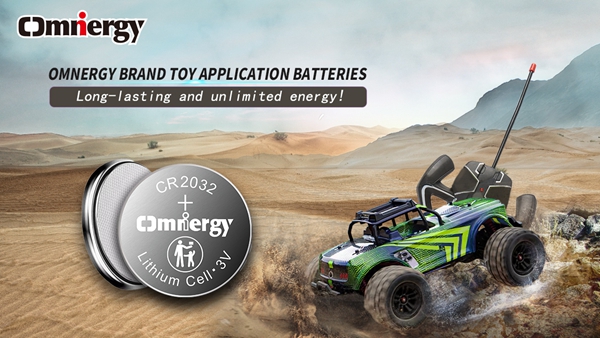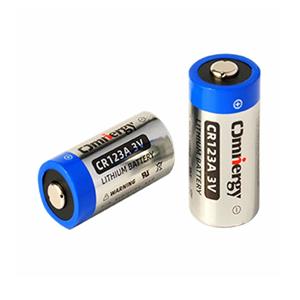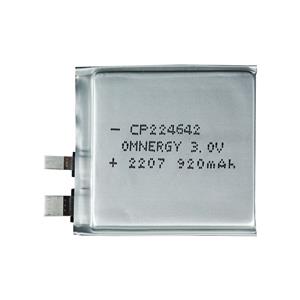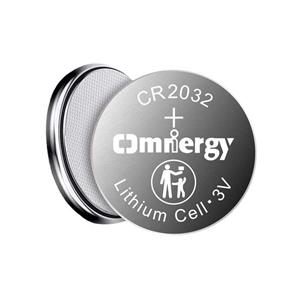Lithium manganese button batteries (such as CR2032 and CR2025) are used in electric remote control toys
Lithium manganese button batteries (such as CR2032 and CR2025) are used in electric remote control toys
I. The core advantages of lithium manganese button batteries
1. High voltage stability
- Constant output: The nominal voltage of lithium manganese batteries is 3V, and the voltage remains almost stable during the discharge process (the discharge curve is flat), which prevents the remote control from weakening or malfunctioning due to voltage drop.
- Pulse current support: When the remote control transmits a signal, it requires an instantaneous high current (about 10-20mA). Lithium manganese batteries can respond quickly and maintain voltage stability to ensure the reliability of signal transmission.
2. Ultra-long service life
- Low self-discharge rate: The annual self-discharge rate is only 1%-2%, and it consumes almost no power when not in use. It is suitable for long-term storage or intermittent use (such as children's toys that may be used again after being idle for several months).
- High energy density: The capacity of CR2032 is about 220mAh, and that of CR2025 is about 150mAh. Based on the typical power consumption of the remote control (0.1-0.3mA), the battery life can reach several months to more than 1 year.
3. Small size and light weight
Compact design: The size of CR2032 is 20mm in diameter × 3.2mm in thickness, and CR2025 is thinner (2.5mm), which perfectly meets the requirements of the remote control for thinness.
Lightweight and portable: A single battery weighs only 2.5-3g, which will not increase the overall burden of the remote control, especially suitable for children to hold.
4. Wide temperature adaptability
- Wide operating temperature range: It can work stably in an environment of -20°C to +70°C, meeting the use requirements of indoor and outdoor remote control toys (such as outdoor remote control car competitions in winter).
5. High safety and environmental protection
No liquid electrolyte: Solid electrolyte is used, which is not easy to leak or corrode the circuit, extending the life of the remote control.
Mercury-free design: It complies with international environmental standards (such as RoHS) and reduces the risk of heavy metal pollution.
2. Reasons for its wide application in electric remote control toys
1. Market demand and product design adaptation
Low power demand: The remote control only needs to power the signal transmission module and the microcontroller, and the power consumption is extremely low. The capacity of the button battery fully meets the demand.
Space limitation: Modern remote controls pursue lightness and compactness (such as folding or card-type design). Traditional AA/AAA batteries are too large, while button batteries can be directly embedded near the PCB board.
2. Typical applications of mainstream remote control toys
Remote control cars/drones: CR2032 is often used for the core power supply of high-end remote controls (such as Traxxas and Tamiya brands) and supports high-frequency signal transmission (2.4GHz).
Children's toy remote controls: CR2025 is widely used in entry-level toys of major brands because it is thinner, with lower cost and easy replacement.
Multi-function remote control: Some remote controls integrate LED screens or vibration feedback, and lithium manganese batteries provide stable power support.
3. User-end convenience
Replace and use: No need to charge, easy to replace, suitable for non-technical users (such as children or the elderly).
Strong compatibility: CR2032 and CR2025 are standardized models (IEC standard), universally used, and easy to purchase and replace.
4. Economic advantage
Low cost per use: A CR2032 costs about 1-2 US dollars and can power the remote control for 6-12 months. The average annual cost is only 1-2 US dollars, which is much lower than the initial investment of the rechargeable solution (charger + battery).
III. Practical application case analysis
1. Remote control car competition
Scenario: Professional RC (Remote Control) racing competitions have extremely high requirements for remote control response speed and signal stability.
Battery selection: Players generally choose CR2032 because its high pulse current capability can support a signal refresh rate of dozens of times per second to avoid control delays.
2. Children's toy remote control
Scenario: Cheap plastic remote controls need to control cost and thickness.
Battery selection: CR2025 is thinner (2.5mm), which can compress the internal space of the remote control while meeting basic battery life requirements (4-6 months).
3. Smart remote control
Scenario: Remote controls that support mobile phone APP linkage require continuous Bluetooth connection.
Battery selection: CR2032 can take into account both standby power consumption (0.05mA) and instantaneous current demand during active connection by optimizing circuit design.
IV. Future application potential
1. Combined with energy harvesting technology: In the future, remote controls may integrate micro solar panels or kinetic power generation modules, and button batteries will be used as energy storage buffer units.
2. Smart power prompt: Display the remaining power through the built-in chip to improve user experience.
3. High safety upgrade: Develop anti-accidental swallowing design (such as bitter coating) to reduce the risk of accidental swallowing by children.
Lithium manganese button batteries have become the "gold standard" for power supply of electric remote control toys with their advantages of high voltage stability, ultra-long life, and extreme lightness. Its wide application is due to the perfect match between technical characteristics and low power consumption requirements, as well as the low cost and high convenience brought by standardized design. In the future, with the improvement of intelligence and environmental protection requirements, lithium manganese batteries will still be the mainstream choice for remote control power supply, and will continue to evolve in material innovation and recycling systems.





